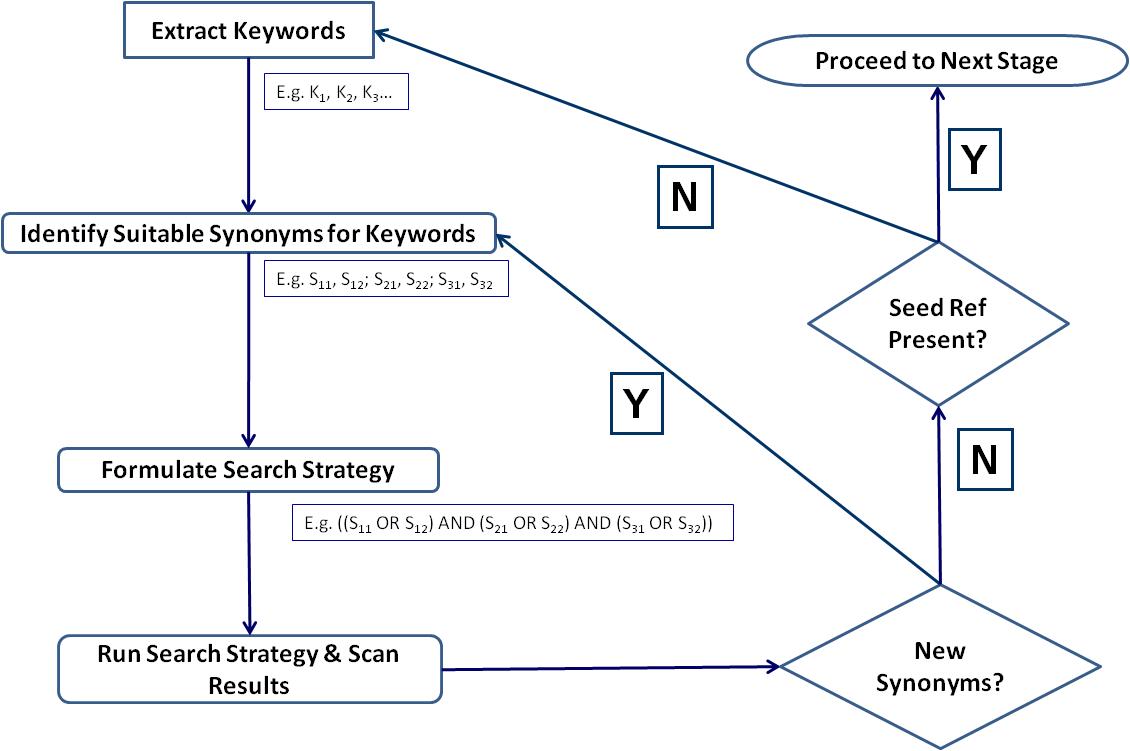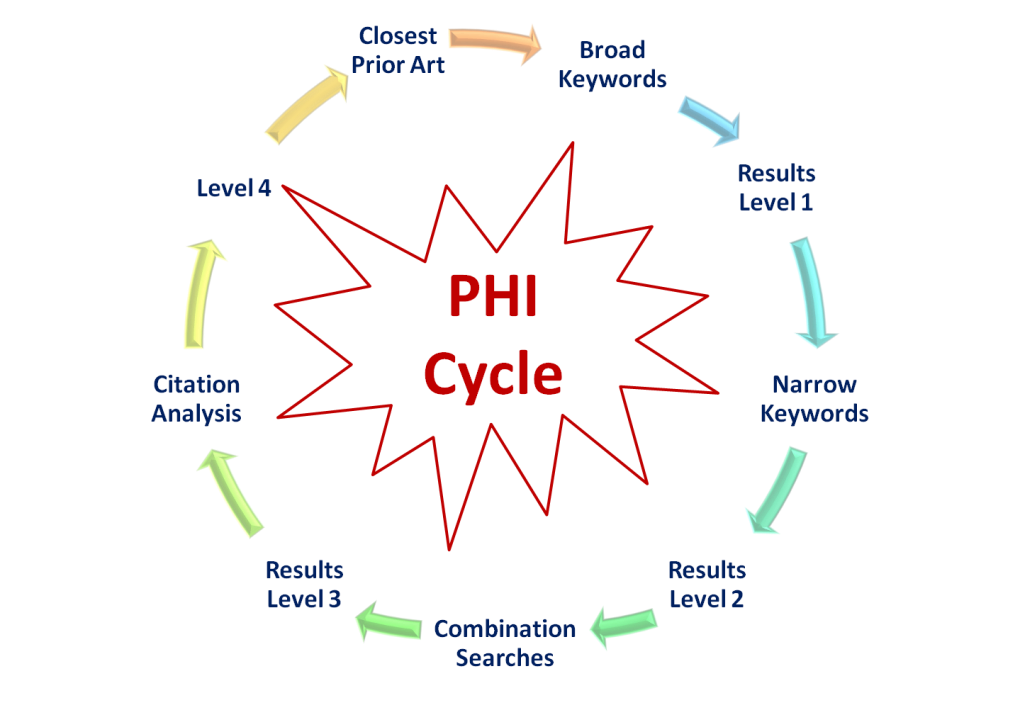PRIOR ART SEARCHING PROCESS
Prior art searching involves a series of steps designed to extract the most relevant references for a specific situation. This situation may range from a novel invention to invalidating a patent or obtaining clearance prior to a product launch. A good place to start looking for relevant prior art would be in the patent databases, as it is well known that patent literature contains more relevant technical information than all other forms of literature put together. Hence, prior art searching requires specialized patent searching, reading and comprehension skills, among other things.
A typical prior art searching process involves several easy to perform steps:
- Obtaining a keen understanding of the subject matter at hand,
- Identifying the relevant field(s) to be searched in an appropriate data source,
- Constructing suitable search strings based on the chosen field(s), and running them on the data source,
- Scrutinizing the results to judge the appropriateness of the search strategy.
Fields of search include:
- Date Fields
- Priority Date
- Filing Date
- Publication Date
- Grant Date etc.
- Assignee/ Applicant
- Inventor
- Title
- Abstract
- Claim
- Classification Codes
Quite often, multiple fields are used to search and arrive at most relevant prior art quickly and efficiently.
Also, typically, ensuring the results showing from a search is relevant or not would involve scanning through at least a handful of some of the hits to see if they match the search criteria. However, an easier way would be to have a seed reference available, and then ensuring that the seed reference is part of the result set. Seed references need to be chosen carefully to ensure that they are of high relevance and as close to the point as possible to the subject matter.
Figure 1 shows an exemplary flowchart with an example of searching using the text fields, such as claims, title, abstract or detailed description as the case may be.

Figure 1. An exemplary flowchart for a search process
A seasoned patent search professional would understand that while one exemplary embodiment has been shown herein, other suitable modifications and additional aspects will become apparent to one skilled in the art and is considered to be within the scope of the description given herein.
IMPORTANCE OF TEXT FIELDS IN PATENT SEARCHES
Keywords based search for prior art in patents database involves the appropriate use of keywords and all possible synonyms and representations of the keywords. An important further feature of keywords search includes the choice of text field in which the keywords are to be searched.
Typical patent contents include the front page, the description or specification and the claims. Front page include several vital information such as: publication number, dates including filing date, publication date and grant date, along with inventors and assignee/ applicant’s name, abstract, and often a typical drawing that is considered illustrative of the invention.
Hence, a typical patent search professional has the options of searching in any of these fields individually or in combination. The nature of the search being conducted will largely determine the choice of the fields of search. To be able to make a judicious choice, the searcher has to understand the role of the various sections of the patent.
Claims are considered to be the heart of a patent, as it is the enforceable portion against potential threats. Description section, as the name suggests, describes the invention in greater detail. From a different perspective, the description section is used by a patent drafter to enable the claims, which means it is used to define the terms used in the claims, and/or explain the concepts in detail. Abstract provides a short description of the distinguishing feature of the invention, while title gives a snapshot of the invention.
Therefore, from the aforementioned, it becomes obvious to the searcher that if one wishes to identify all patents that are enforceable for a given concept, then the search for the concepts has to be conducted in the claims section. On the other hand, if the search is meant to identify all the patents that disclose some features of interest, then the search has to be extended to all the sections without any limitation.
Quite often, a search in all sections of the patents can result in a large number of results that allows for a meaningful analysis. In such situations, one useful technique to limit the results would be to search within the title, abstract or claims. The difference in the number of hits when the field of search is changed from all sections to only claims, title and abstract can be quite vast, sometimes as much as a 1/3rd drop in the number of hits. The relevance of the hits also sometimes improves by limiting to these fields of search.
The flip side of the above situation is that by searching in the title, abstract or claims, it is also possible that very relevant results may be missed out. Depending on the kind of search conducted, the number of such relevant results could be a few or many. Regardless of the number of hits, the simple fact of the matter is that these are relevant hits and in principle, they cannot be ignored. This means that a search in the description also needs to be performed.
Hence, the searcher has to be very judicious in choosing or eliminating search fields for a particular search project. The trick is to find the balance between getting few very relevant hits with the risk of losing out on relevant hits versus sifting through a large data set enduring several irrelevant hits to identify the most relevant ones. The ability to find this balance quickly and efficiently distinguishes the good searcher from the novice in the field.
KEYWORDS BASED PRIOR ART SEARCHING
Patent searching is an involved process that necessarily requires technical expertise and knowledge of structure of patent documents. While searching can be achieved through many different means, keywords based searching is the most commonly used technique by searchers. This may be due to a certain level of comfort and familiarity associated with keywords based searching method. Who among us hasn’t opened a browser and searched for something we wish to learn more about using a suitable internet search engine like Google? The principles applied towards such searching are directly extended to patents searching as well by the uninitiated and the incumbent in this field. However, it takes some experience to know and understand that direct extension of these principles is not an ideal way to go about searching for patents.
One of the aspects of prior art searching- much like any common searching on a search engine- includes the fact that the requirement to verify if the search is right or off track is vested with the searcher. The search engine will only throw up results regardless of the subject of the search, as long as the keywords are present in the pages searched. It is up to the searcher to review the results to see if the hits are accurate or off target. Keywords based patents searching is similar in that respect. A search for some keywords will always give results. But whether the results are what is expected or off target is determined by the user. Database providers give some insights about the hits by giving some parameters like relevance percentage or some such similar measure. However, most searchers use these values with extreme caution, if at all.
One of the aspects about keywords based searching is that the keywords involved are typically very technical in nature. Consequently, thorough knowledge of the technology in question is vital to ensure all the keywords are used while searching. In this way, all different ways of expressing the same concept can be covered, so that all patents that use any of the keywords will be retrieved. For in patent searching, it is necessary to identify all relevant documents, not just some of them or most of them.
This puts an extra burden on the searcher to be fully aware of the technology, and know how the same concept is represented verbally. For example, a watch may also be known as a timepiece or chronometer or a horometer. Unless the searcher is aware of the existence of such keywords that represent the same concept as watch, the searcher is liable to miss these patents that use these words. Even if there is only one patent that uses one of these words, it may still be a significant and relevant to the situation, and hence cannot be missed.
Keywords based searching involves further difficulties in that the same word may be represented in different ways by different patent drafters. Taking the same example given above, the word ‘timepiece’ could be written as a single word or as two words separated by a space ‘time piece’. The keywords can be represented as singular or plural as well. Databases provide assistance in covering all such variations, but it is still necessary for the searcher to be aware of these aspects, and account for it while conducting the search.
Technical terms also evolve with time, just as language evolves with time. Hence, a term used when the technology was at its nascent stages may not be used during the later stages of development. The searcher has to be keenly aware of this evolution of technical language.
Further complications can arise due to translations from other languages, especially from non-Latin based languages such as Japanese and Chinese. The terms that arise from the translations could be different from what is known to the technical experts. The searcher has to find a way to extract these terms as well and use it in their search strategy to ensure no prior art will be missed out.
Thus, to summarize, the complications that could potentially trip up a searcher during keywords based search include the following:
- Gathering all possible synonyms
- Understanding language variations over time
- Spelling variations
- Translations
The searcher needs to check at least these boxes off while coming up with search strings to ensure the search strategy is comprehensive.
The Patent Human Interaction Cycle
Techno-legal documents not only include the technical know-how but also exclude others to prevent or stop using, make or selling the said invention. It has every bit of knowledge about the invention that anyone can utilize to replicate the same whenever required. So, it becomes a key point to showcase your novel idea. One can gather any sort of information to locate for numerous purposes and provide fruitful juices to the Patent Searchers, Patent Attorney and also, to the Patent owner(s).
Patent Searching by an individual or an organization is an essential part at various stages of patenting phase, from the filing of patent application to its grant and even afterwards. So, picking up the relevant and strong prior art becomes an art for proficient researcher. The process is very iterative. It includes exhaustive search strategy that in turn includes search by keyword, classes, inventor /assignee and last but not the least citation study.
This process begins with the use of broad keywords that result in some broad results. It can judge in a way when one interacts with the patents by skimming and scanning. It leads the search direction not only to the narrowing down the keywords but also to the combine search with the relevant classification codes. Again, some results will come over and then more refinement will come into picture for example, citation study. So on, the cycle goes on until the one retrieve the closest prior arts.

Such interactive mode of a human with the patent document led to discover the Patent Human Interaction Cycle or PHI Cycle. Every patent researcher one way or another revolves around every segment, until one can take out the bang on hit. Doesn’t it look like a Game, where each and every level becomes harder until one wins it?